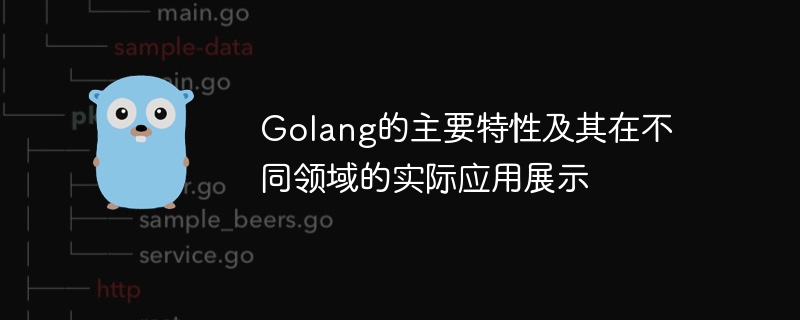Home >Backend Development >Golang >Golang's main features and its practical applications in different fields
Golang's main features and its practical applications in different fields
- WBOYWBOYWBOYWBOYWBOYWBOYWBOYWBOYWBOYWBOYWBOYWBOYWBOriginal
- 2024-03-06 08:18:031318browse

The main features of Golang (Go language) and its practical application in different fields
As an emerging programming language, Golang has been Much attention and favor. It delivers industrial-grade performance and efficiency and is designed to be simple, easy to read, and easy to maintain. This article will introduce the main features of Golang, as well as its practical application in different fields, and attach relevant code examples.
The main features of Golang
- Strong concurrency performance: Golang has built-in natively supported concurrency features and achieves efficient concurrent programming through goroutines and channels.
- Built-in garbage collection: Golang has an automatic memory management mechanism and a built-in garbage collector, which does not require programmers to manually manage memory.
- Static typing: Golang is a statically typed language that can detect errors during compilation and improve the quality of the code.
- Simple and easy to read: Golang syntax is simple and clear, easy to learn and understand, reducing the complexity of the code.
Exhibition of the application of Golang in different fields
Web development
Golang is widely used in the field of Web development. Its fast performance and powerful concurrency features make it Become an ideal choice for developing web services. The following is a simple HTTP server example:
package main
import (
"fmt"
"net/http"
)
func handler(w http.ResponseWriter, r *http.Request) {
fmt.Fprintf(w, "Hello, World!")
}
func main() {
http.HandleFunc("/", handler)
http.ListenAndServe(":8080", nil)
}Cloud Computing
Golang’s concurrency features and built-in network libraries are widely used in the field of cloud computing, such as writing distributed systems and microservices. The following is a simple example of concurrent processing:
package main
import (
"fmt"
"time"
)
func worker(id int, jobs <-chan int, results chan<- int) {
for j := range jobs {
fmt.Println("worker", id, "processing job", j)
time.Sleep(time.Second)
results <- j * 2
}
}
func main() {
jobs := make(chan int, 100)
results := make(chan int, 100)
for w := 1; w <= 3; w++ {
go worker(w, jobs, results)
}
for j := 1; j <= 9; j++ {
jobs <- j
}
close(jobs)
for a := 1; a <= 9; a++ {
<-results
}
}Data processing
Golang is also widely used in the field of data processing. Its efficient performance and concurrency mechanism make it a good choice for processing big data. . The following is a simple example of file reading and processing:
package main
import (
"fmt"
"io/ioutil"
)
func main() {
data, err := ioutil.ReadFile("data.txt")
if err != nil {
fmt.Println("File reading error", err)
return
}
fmt.Println("Contents of file:", string(data))
}Conclusion
In general, Golang, as a modern programming language, has powerful concurrency performance, concise and easy-to-read syntax and a wide range of applications. Through the above sample code, we can see the practical application of Golang in web development, cloud computing and data processing. I hope this article will be helpful to readers' learning and understanding of Golang.
The above is the detailed content of Golang's main features and its practical applications in different fields. For more information, please follow other related articles on the PHP Chinese website!

